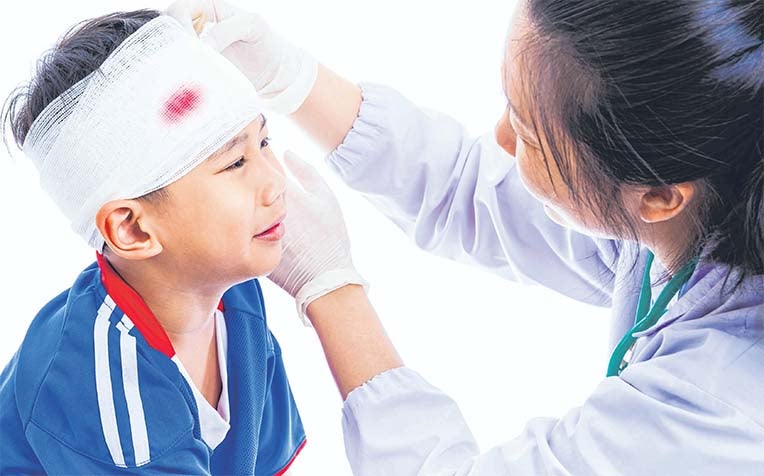
in the study who were involved in a traffic accident, more than 50 per cent were pedestrians.
All children take a tumble every now and then. While most knocks can be brushed off, some could end up with serious consequences.
Every year, about 4,700 to 5,500 children show up with head injuries at the emergency department of KK Women’s and Children’s Hospital.
A recent study involving more than 1,000 of these children from two local hospitals found that seven in 10 head injuries had been sustained in a fall.
The study, reported in The Straits Times earlier this month, was conducted by doctors from the KKH and the National University Hospital (NUH).
They examined head injuries in 1,049 children between 2011 and 2015.
The children were all under 16 and needed a computerised tomography (CT) scan or admission to hospital for further monitoring.
Even though falls tend to result in less severe injuries – compared to traffic accidents, for instance – doctors said that parents should still take them seriously.
In fact, “the likelihood of a severe outcome increased by 1.4 times with every metre increase in the height of the fall”, said Dr Chong Shu-Ling, a staff physician at KKH’s emergency medicine department. She added that adults should pay particular attention to children under the age of two, as these are the crucial years of rapid brain development.
Half the falls – or around 400 cases – happened at home, with the majority tumbling off a sofa or an adult’s bed.
The relatively large size of children’s heads, in comparison to their bodies, predisposes them to head injuries in the event of a fall, she said.
Besides falls, the other head injuries were attributed to traffic accidents, sports, interpersonal violence and non-accidental trauma, or grouped under a general category called “others”.
The worst injuries came from vehicle accidents and were often preventable, for instance, by not putting young children in the front passenger seat or making sure they used child seats in cars and wore helmets when on bicycles.
Only 11.7 per cent of the head injuries in the study were found to be caused by vehicle accidents. But these had the worst outcomes, including long-term disability or death.
“The study found that road traffic collisions were associated with severe paediatric head injuries, where the child required neurosurgery or airway intervention, or died,” said Dr Chong.
The study also included children who subsequently died from their injuries. It excluded those whose injuries were relatively minor.
Dr Chong said the main impetus of the study was to understand the main causes of severe head injuries among children, in order to help prevent them.
Among the 123 children in the study who were involved in a traffic accident, over half of them were pedestrians.
The remainder were passengers in or on vehicles – including cars, bicycles and motorbikes. Dr Chong said three-quarters of this group were not using car restraints or wearing helmets at the time of the accidents.
In addition, Dr Lim Yang Chern, an associate consultant in NUH’s children’s emergency department, said nearly a fifth of the children under 10 were found to have been in the front passenger seat. Children below 12 should ride in the rear, he pointed out.
Paediatrician Low Kah Tzay, who is with Mount Elizabeth Hospital, said parents may put their child at risk by overlooking dangerous situations.
For example, they may hold their baby in their arms during a car ride. “When there is an accident or when the emergency brakes are suddenly applied in the vehicle, the baby would be thrown out of the caregiver’s arms.”
Some parents forget to ensure that their child wears a helmet when riding a bicycle with training wheels, while others fail to fasten the restraints in a pram.
What makes the difference in the severity of an injury is the force of impact, said Dr Lim. In falls, this force is relatively minor.
“However, many road traffic accidents often occur at a high velocity and result in more severe trauma.”

KEEPING KIDS SAFE
How can adults prevent children from getting head injuries?
Dr Chong Shu-Ling, a staff physician at KK Women’s and Children’s Hospital’s emergency medicine department, gives some tips.
BABIES AND TODDLERS
- Do not leave them unattended for any amount of time on an adult bed or a baby cot with no proper barrier to prevent them from falling.
- Do not use a sarong cradle. Many head injuries – and even deaths – occurred when infants fell out of the sarong or when the cradle broke.
- Do not use a baby walker.
- Falls from walkers are not uncommon and have been documented both in Singapore and overseas.
- If your child is seated in a high chair, make sure that it is sturdy. Always fasten the seat belt.
- Use a car seat that is appropriate for his age.
SCHOOLGOING CHILDREN
- Make sure they are closely supervised in playgrounds. Do not let them play in unsafe playgrounds, for example, those that are poorly maintained and with equipment that are rusty or of an unsafe design.
- Make sure they use properly fitted helmets when taking part in activities such as cycling and rollerblading, or when using a kick scooter.
- Make sure they use proper restraints, such as seat belts or booster seats, in a vehicle.
- Do not allow them to go on the roads unsupervised. Teach them road-safety habits.
Contributed by














 Get it on Google Play
Get it on Google Play